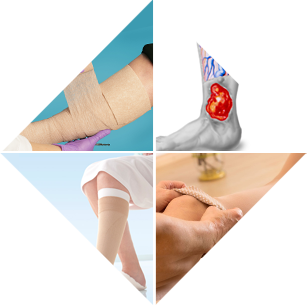
Varicose Ulcer Treatment
What is it?
A skin ulcer usually means a loss of a patch of skin due to
several reasons. In your case, the reason is the veins just
under the ulcer. Your veins are a little bigger than normal.
These are called varicose veins because they look a bit like a
wine bottle from ancient Greece (varix). A varicose vein is a
superficial (close to the surface) vein lying under the skin. It
gets swollen because of overspill of blood from veins running
deep in the muscles of the legs.
This occurs when the leg veins don't return blood back toward
the heart the way they should. The problems with your varicose
veins are not their size, but the high pressure and sluggish
flow of blood inside them. These results in aching, cramping,
itching, staining of the skin, eczema and finally ulcers. The
ulcers are often very painful. They can bleed and get infected.
In the long term they can range from a minor handicap to
possible serious illness. Most varicose ulcers will heal. The
key to the treatment is to put continuous pressure on the
underlying veins. One of the best ways of doing this is to
squeeze the veins with bandaging.
The latest way of bandaging is to use four different types of
bandage all at the same time. This is what you may have. The
pressure dressing is far more important than any ointments,
powders, granules, or dressings on the skin. Sometimes the blood
supply is not good to the leg. The skin is starved of blood and
gets damaged by the pressure. The doctors may need to do special
tests and suggest other treatment for this.
You will not need to have any anesthetic. The aim is to get your
ulcers healed. This means you wear a bandage on your leg for as
long as it takes. Most people heal up inside 16 weeks. You need
to have the bandages changed each week. Your ulcers are measured
to make sure they are healing up. Once the ulcers have
healed,the aim is to retain the recovery. This might mean
injection treatment, or an operation for some people. For
others, some type of support stocking may always be needed. When
you see the surgeon, he will check you have straightforward
varicose ulcers and nothing else. He will also look into any
other surgical problems you may have.
The Surgery
Before surgery you will need a period of bed rest and elevation
of the legs to reduce the swelling (oedema) of the legs. At the
same time you will be given antibiotics to reduce the
inflammation (cellulitis) of the skin around the ulcers.
The first step of the operation is for the ulcers to be
measured. A probe test may be done to check the circulation. A
specimen of the discharge is taken for the laboratory to examine
for the presence of any bugs in the ulcers. This will guide the
antibiotic treatment that you will need in the future. The
ulcers are cleaned. A non-stick dressing is put on the ulcer.
Four layers of special bandages are wrapped round your leg from
the knee down to the base of your toes. The doctors arrange the
OPD consultation weekly. You may need to take antibiotics when
they have a report from the laboratory.
Any Alternatives
There are dozens of dressings, powders, sprays, etc. in the
market, but of no use. You can get the ulcer to heal by getting
rid of the excess pressure in the veins simply by going to bed
with your feet up. This takes about three weeks. It may be best
to do this in hospital. Skin grafting on its own is not very
effective.
Before the operation
All your old dressings are taken off. You are given a general
check over.

